Milan, from March 22 to April 30, 1967.
- Mondo Beat presents a complaint to the Court of Milan against the Police Headquarters, which suspends the mandatory expulsion measures against the Beats and authorizes a Mondo Beat demonstration.
- Dante Palla finds a suitable place to create a tent city.
On March 24, the trial of Pierluigi Perronace Principe, a Beat who had participated in many demonstrations of the Movement, took place. He had been arrested by the police because he had not complied with the mandatory expulsion order received from the Police Headquarters. But, since he lived in a small town on the outskirts of Milan, namely Bollate, a similar expulsion order from Milan would have prevented him from leading a normal life, so he had not respected it. Arrested by the police in Milan, he had been jailed for a week and then taken to court. Two young lawyers, made available by Onda Verde, defended him. They explained how it was impossible for Pierluigi Perronace to lead a normal life without going to Milan. In turn, Melchiorre Gerbino testified that Pierluigi Perronace was a painter and had to go to Milan to purchase painting materials that he could not have found in Bollate. Despite all this in his defense, Pierluigi Perronace was sentenced to a month in prison (but with probation) and the magistrate who tried him declared that the compulsory expulsion order he had received was still valid, therefore he was condemned not to frequent Milan during 3 years. In truth, to penalize the Beats, Italian justice resorted to worse sentences than those that the South African apartheid system imposed on Blacks.
After this verdict, to free himself from the grotesque situation he found himself in, Pierluigi Perronace left Italy for India.
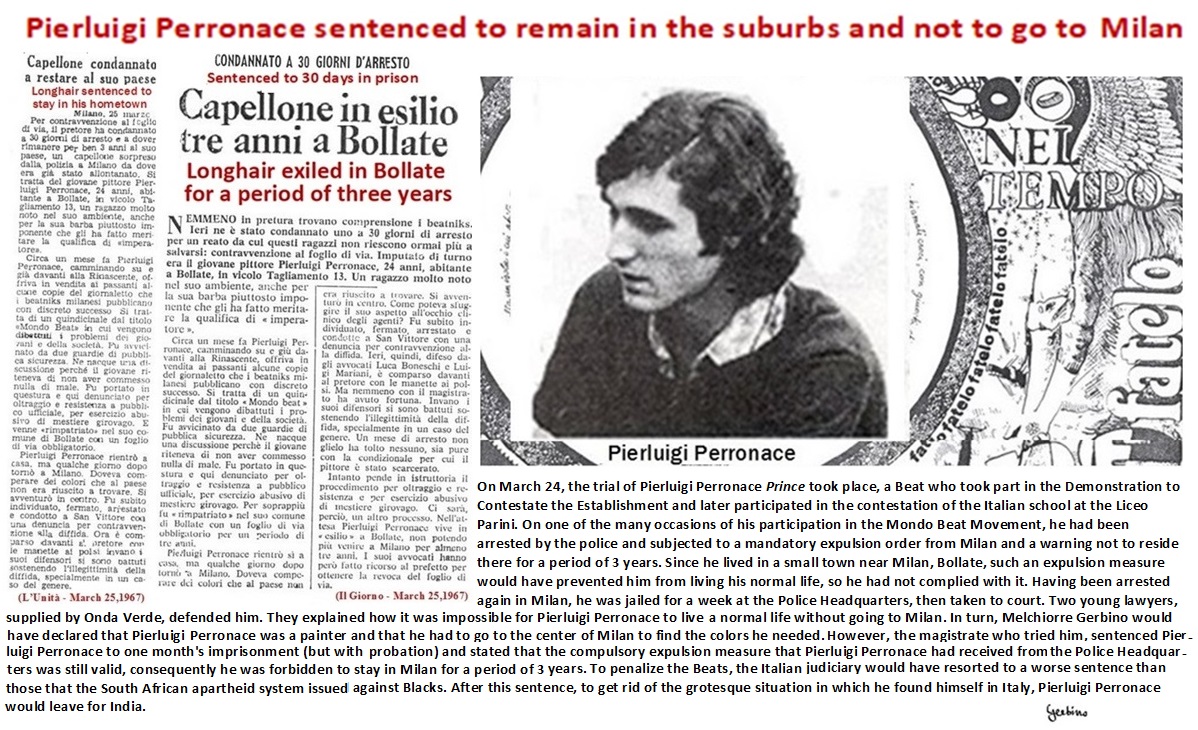
Pierluigi Perronace sentenced to stay in the outskirts of Milan and not to go to the city center.
Returning to the chronological reconstruction of the history of Mondo Beat, on March 28, 1967 the press gave the deafening news of Beats' arrest for trafficking and hashish consumption.
This was the first move of a new strategy that the establishment implemented against the Beats. Unable to repress their Movement with the police, the establishment would have resorted to a press campaign to describe the Beats as shady young people involved in trafficking and hashish consumption.
To carry out this press campaign against the Beats, the collaboration of Fernanda Pivano was requested. Fernanda Pivano, a CIA agent, had already trapped half a dozen young people in her literary salon and had initiated them into smoking hashish, with the aim of making them inactive. All these young people had been among the most active in the Movement and Gianni Scarpelli, leader of the Palumbo Group, having been the most active among them, was hated by those who hated the Movement and was chosen to pay the highest price.
He was arrested and sentenced to 8 months in prison. His case had deafening media coverage, being the first in Italy of a person arrested and convicted for smoking hashish. In turn, Fernanda Pivano would also have had wide media coverage, since she would have obtained a special permit for Gianni Scarpelli, that is, he would have been allowed to paint in his cell. Gianni Scarpelli was not a painter, but the Police Headquarters and the Corriere della Sera would have insisted on defining him as a painter, so that Fernanda Pivano could end up in the news for having obtained a special permit for him.
Gianni Scarpelli,who was a seller of secondhand items in local markets, died suddenly a few years after this affair, but this is not surprising, since quite a few people from the Movement died young.
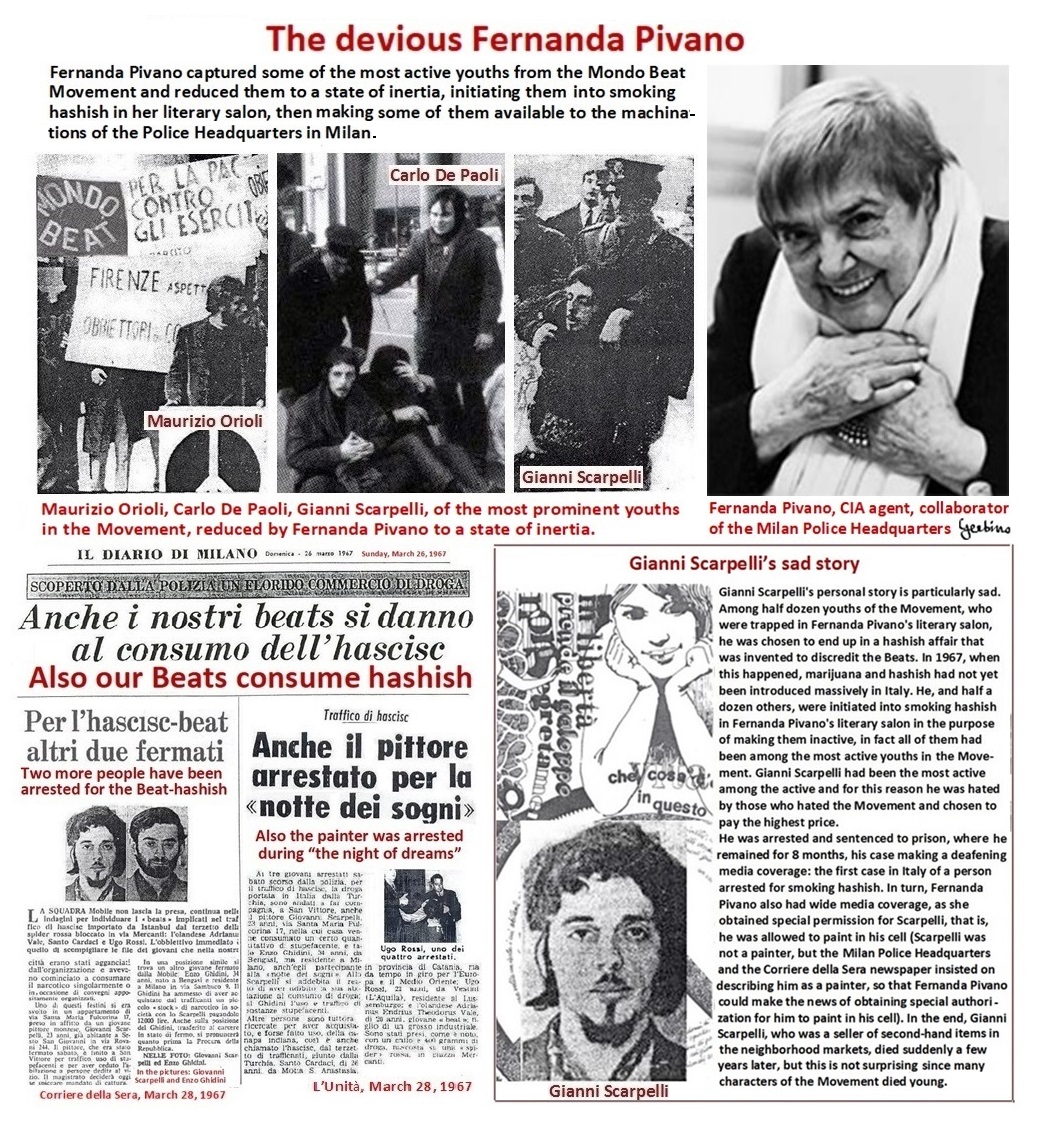
The devious Fernanda Pivano. The sad story of Gianni Scarpelli.
Since this hashish affair was invented to throw bad light on the Beats, Melchiorre Gerbino intervened in the newspapers to declare that Mondo Beat was stranger to all of this. And from that moment on, Melchiorre Gerbino would openly show aversion and contempt towards Fernanda Pivano, so that the youths of the Mondo Beat Movement would understand that she was a devious character.
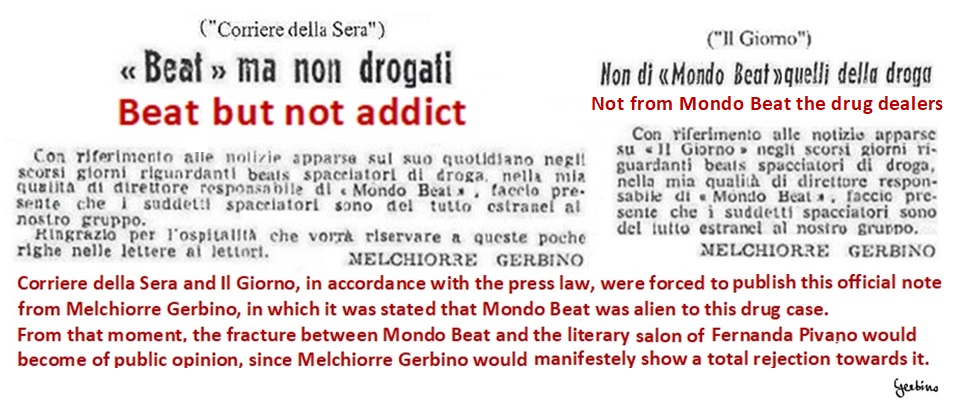
Beats but not addicts.
Let's now talk for a moment about Allen Ginsberg, given that at the time of Mondo Beat he came to Italy to collaborate with Fernanda Pivano and in fact the two together founded the magazine Pianeta Fresco and promoted cultural events that received great publicity from the establishment media.
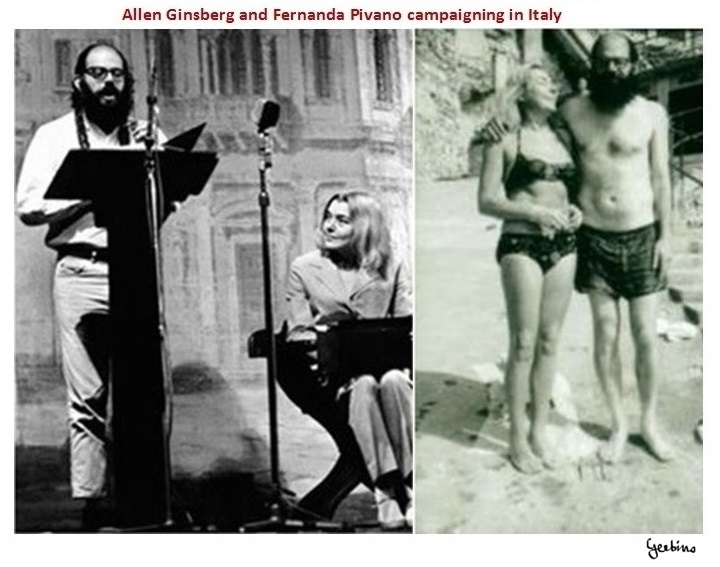
Allen Ginsberg and Fernanda Pivano campaigning in Italy.
Fernanda Pivano had the task of confusing young Italians with a sensational media campaign on the Beat Generation, a generation older than theirs, and she did so with the aim of diverting them from participating in the Mondo Beat Movement, a movement contemporary to the Free Speech Movement and the Provobeweging and animated by the same motivations, namely the affirmation of civil rights and the protection of the environment. So the point is: could Allen Ginsberg not have been aware of the real activity of Fernanda Pivano, let's say, could he not have understood that Fernanda Pivano was in the service of the CIA?
Or was Allen Ginsberg also colluding with the CIA?
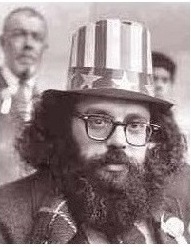
This suspicion is strengthened by the difficulty of otherwise explaining how such a mediocre poet (yes, Allen Ginsberg was a mediocre poet) would have been celebrated to the point of paroxysm.
Of course, others may have other appreciations for Allen Ginsberg's poetics, but whatever the appreciations, the fact remains undeniable that Allen Ginsberg promoted, together with Fernanda Pivano, a deafening campaign on the Beat Generation, aimed to divert the attention of young Italians from the commitment to assert civil rights in their country.
*
Returning to the chronological reconstruction of the Mondo Beat Movement, on March 31, 1967, Gunilla Unger and Melchiorre Gerbino left the apartment of Via Bernardo Rucellai where they had lived for 18 months. Gunilla went to Sicily to visit their son Nino, who lived with the paternal grandparents. From that day Melchiorre Gerbino slept in the Cave.
On April 3, assisted by the lawyers Alessandro Garlatti and Carlo Invernizzi and accompanied by 200 youths of the Base of Mondo Beat, Melchiorre Gerbino filed a complaint with the Court against the Police Headquarters. The two lawyers, Alessandro Garlatti and Carlo Invernizzi, were those who had come to the Cave the day after the Demonstration to Contestate the Establishment and offered their patronage. They had thus prepared documentation on the abuses that the agents of the Milan Police Headquarters had committed against the young people of the Mondo Beat Movement.
A copy of the documentation of the complaint was sent to the Minister of Justice and another to the Minister of the Interior.
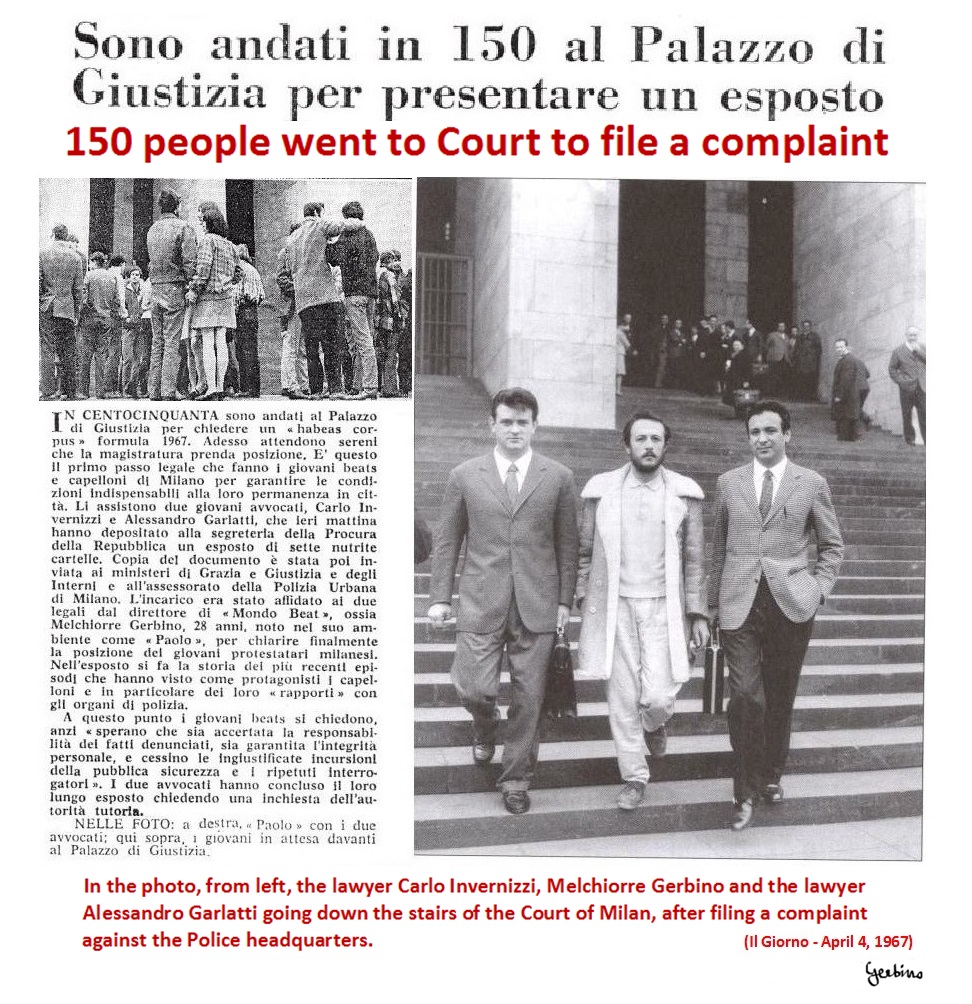
150 people went to Court to file a complaint. (Il Giorno - 4 April 1967).
From left, the lawyer Carlo Invernizzi, Melchiorre Gerbino and the lawyer Alessandro Garlatti descending the stairs of the Court, after filing a complaint against the Milan Police Headquarters.
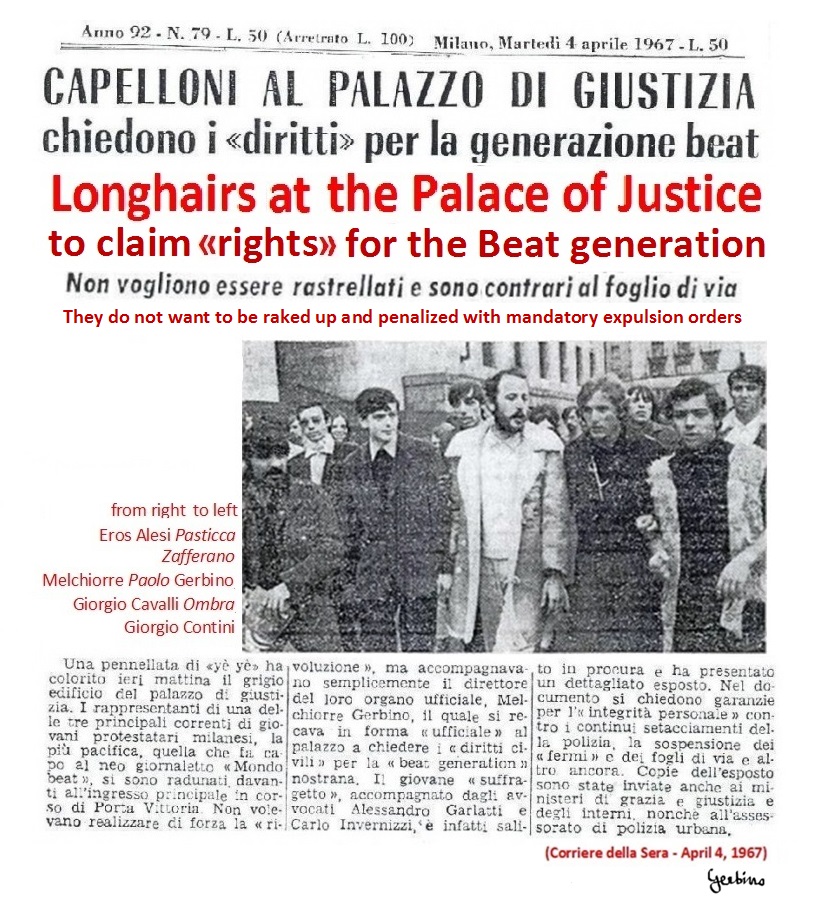
Longhairs at the Palace of Justice to claim "rights" for the Beat generation. (Corriere della Sera, 4 April 1967).
In the photo, the first from the left is Giorgio Contini, then Giorgio Cavalli Ombra, Melchiorre Gerbino, Zafferano, Eros Alesi Pasticca.
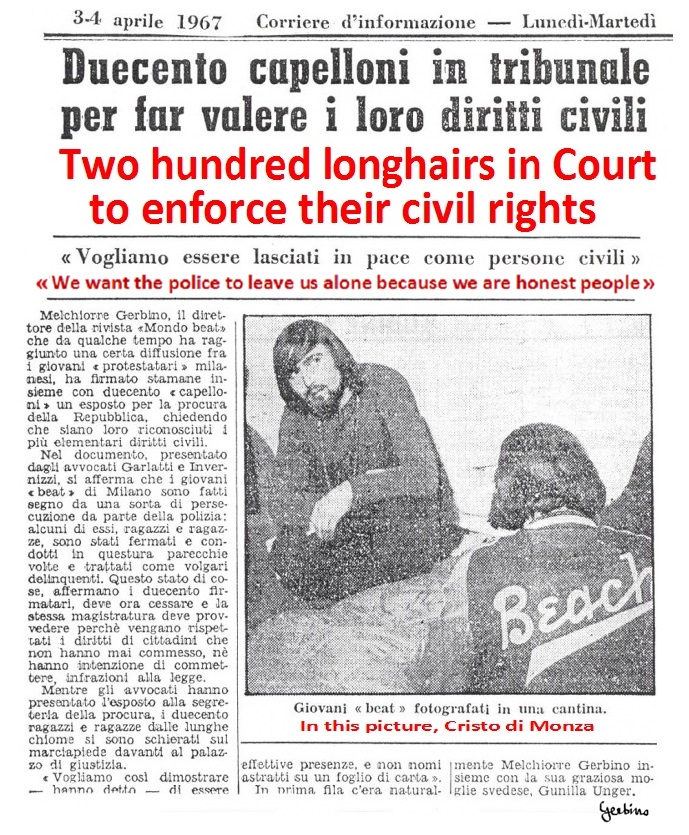
Two hundred longhairs in Court to enforce their civil rights. (Corriere d'informazione, 3-4 April 1967).
In the photo, Cristo di Monza.
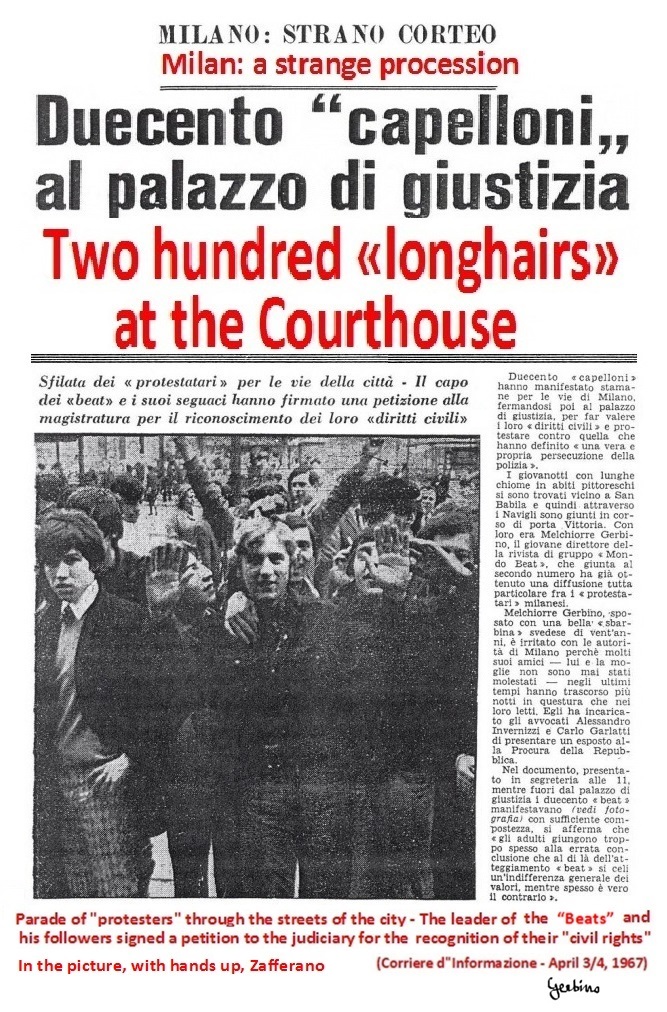
A strange procession. Two hundred longhairs at the Courthouse. (Corriere d'informazione, 3-4 April 1967).
In the photo, with hands up, Zafferano.
Note. The Corriere d'formazione published two editions on the same day, with two articles on Mondo Beat, and this second one on the front page.
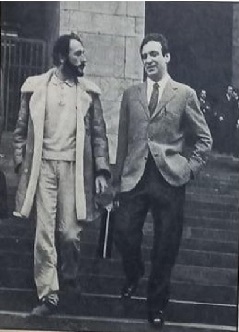
Melchiorre Gerbino and the lawyer Alessandro Garlatti leaving the Court House after submitting a complaint against the Headquarters. (photo from Il Borghese magazine).
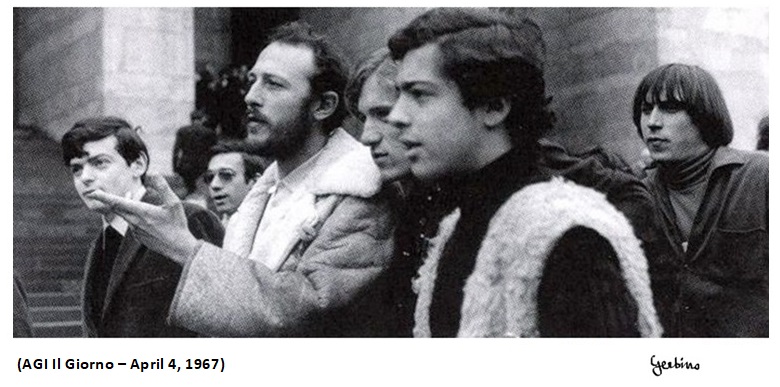
From left, Giorgio Cavalli Ombra, Melchiorre Gerbino, Zafferano (his face is half-covered) and Eros Alesi Pasticca.
After submitting the complaint against the Police Headquarters, they were returning to the Cave, which was located 200 meters from the Court.
Thus, the same youths who had been at the forefront of the Demonstration to Contestate the Establishment would have filed a complaint against the Police Headquarters in the Court. Indeed, the youths of the Base of Mondo Beat were the first activists to affirm civil rights in Italy. What they did in risky demonstrations, as well as in legal actions, was unprecedented and their example of promoting a more dignified society was understood and followed first by other young people from different social backgrounds, then by the mass of Italians.
On April 5, that is, two days after the complaint was presented to the Court, the secretary of the Lombard Youth of the Republican Party showed up at the Cave and said that the Minister of Justice, who was a politician of the Republican Party, had received a copy of the complaint and was willing to receive Melchiorre Gerbino in Rome.
Melchiorre Gerbino thanked the secretary and assured him that he would go to Rome as soon as possible.
But in reality Melchiorre Gerbino didn't want to go to Rome to be photographed with the minister (they took so many photos of him in Milan!). Instead, he would have tried to use the opportunity to find a compromise with the Milan Police Headquarters, so he implemented a bluff. He summoned all the young people who were in the Cave and solemnly declared that he would go to Rome to ask the Minister of Justice to sanction some high-ranking officers of the Milan Police Headquarters. At this point the police informants, who were never missing at the Cave, ran to the Police Headquarters to give the news and it wasn't long before Gaetano, the owner of the bar across the street, looked for Gerbino, because someone was asking of him at the telephone...
"Antonio Saccardo speaking. I am a commissioner of the Police Headquarters. Signor Gerbino, I would be happy to speak with you. I ask this not officially, but in an informal and friendly way."
"Signor Saccardo, it would be a pleasure for me to meet you."
"Can I come with a driver to pick you up?"
" Yes, sir, I will be here waiting for you."
Antonio Saccardo was a Neapolitan gentleman in his fifties, gray hair, robust build. He was a little lame and while walking through the premises of the Police Headquarters, which Antonio Saccardo liked to show to Melchiorre Gerbino, he leaned with one hand on a stick and with the other on Gerbino's arm. He praised Gerbino for his intelligent attitude in educating the youths of the Mondo Beat Movement to respect police officers and not to argue with them even when they were arrested.
As they were proceeding with the walk through the premises of the Police Headquarters, Antonio Saccardo told Melchiorre Gerbino about his life, when in Naples, as a young lawyer, he had manifested antifascist attitudes which had created a world of problems for him, so that, to get rid of them, he had to enlist as a volunteer in the police. But when the time of the Resistance arrived, he joined it. Thus, he was assigned to a clandestine radio which was located in the center of Milan, just a few meters away from where the German radio was located, and for this reason, and because it transmitted very short messages, the Germans never found it (this was a famous story).
Speaking with Melchiorre Gerbino, Antonio Saccardo assumed a good-natured attitude, as from father to son, which would not have embarrassed Gerbino, as in some way it was sincere.
In the end Antonio Saccardo and Melchiorre Gerbino would have easily reached an agreement, given that the Police Headquarters would no longer have imposed compulsory expulsion measures for the youths of the Mondo Beat movement and Melchiorre Gerbino would have avoided meeting the minister in Rome. To formalize the new course, Antonio Saccardo and Melchiorre Gerbino agreed on a public demonstration, organized by Mondo Beat and authorized by the Police Headquarters.
Mondo Beat demonstration authorized by the Police Headquarters. Milan, 8 April 1967.
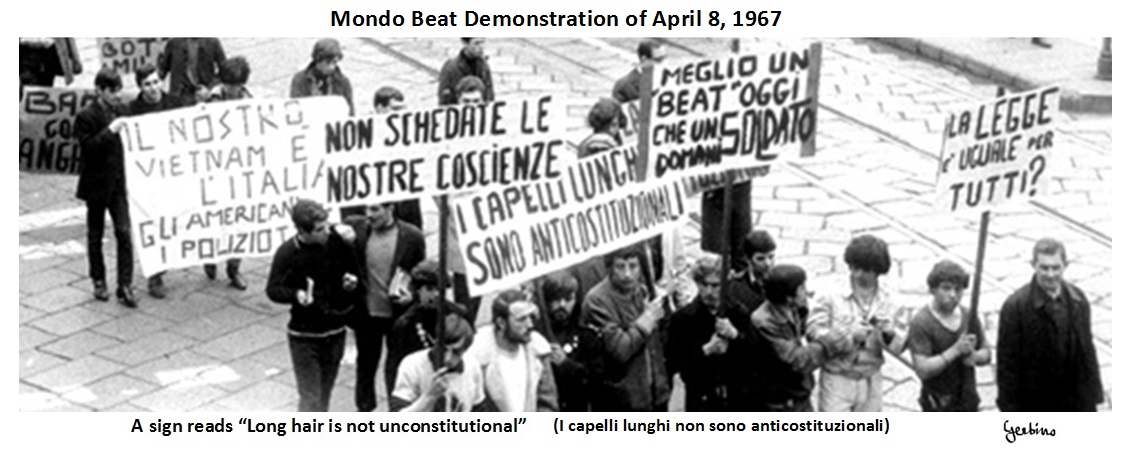
A sign reads I CAPELLI LUNGHI NON SONO ANTICOSTITUZIONALI (Long hair is not unconstitutional).
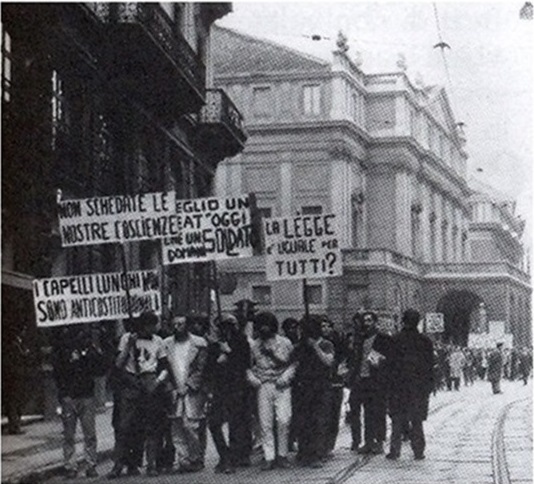
The demonstration proceeds along Via Mercanti. In the background, the Teatro alla Scala.

The demonstration proceeds in Corso Vittorio Emanuele II.
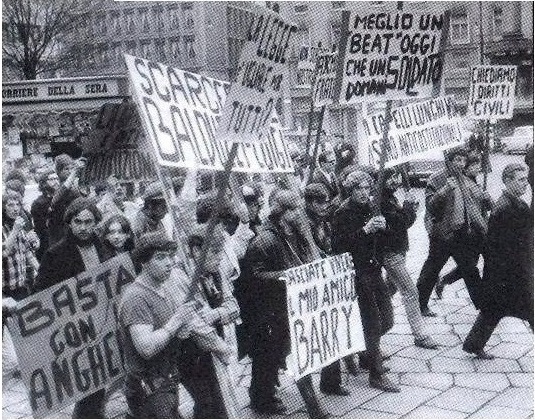
Eros Alesi Pasticca in a T-shirt. He was 16 at the time, looked almost like a child. And what a temper! He was in a T-shirt, while everyone else was wearing warm clothes. The demonstration proceeding through Piazza Fontana.
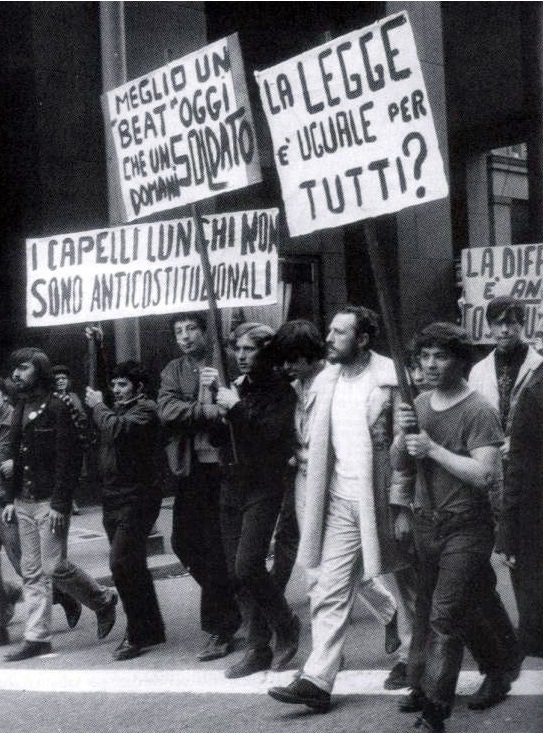
The first on the right is Eros Alesi Pasticca, on his left Melchiorre Gerbino, then Zafferano; the last one on the left is Cristo di Monza. The demonstration is about to reach Piazza Duomo.
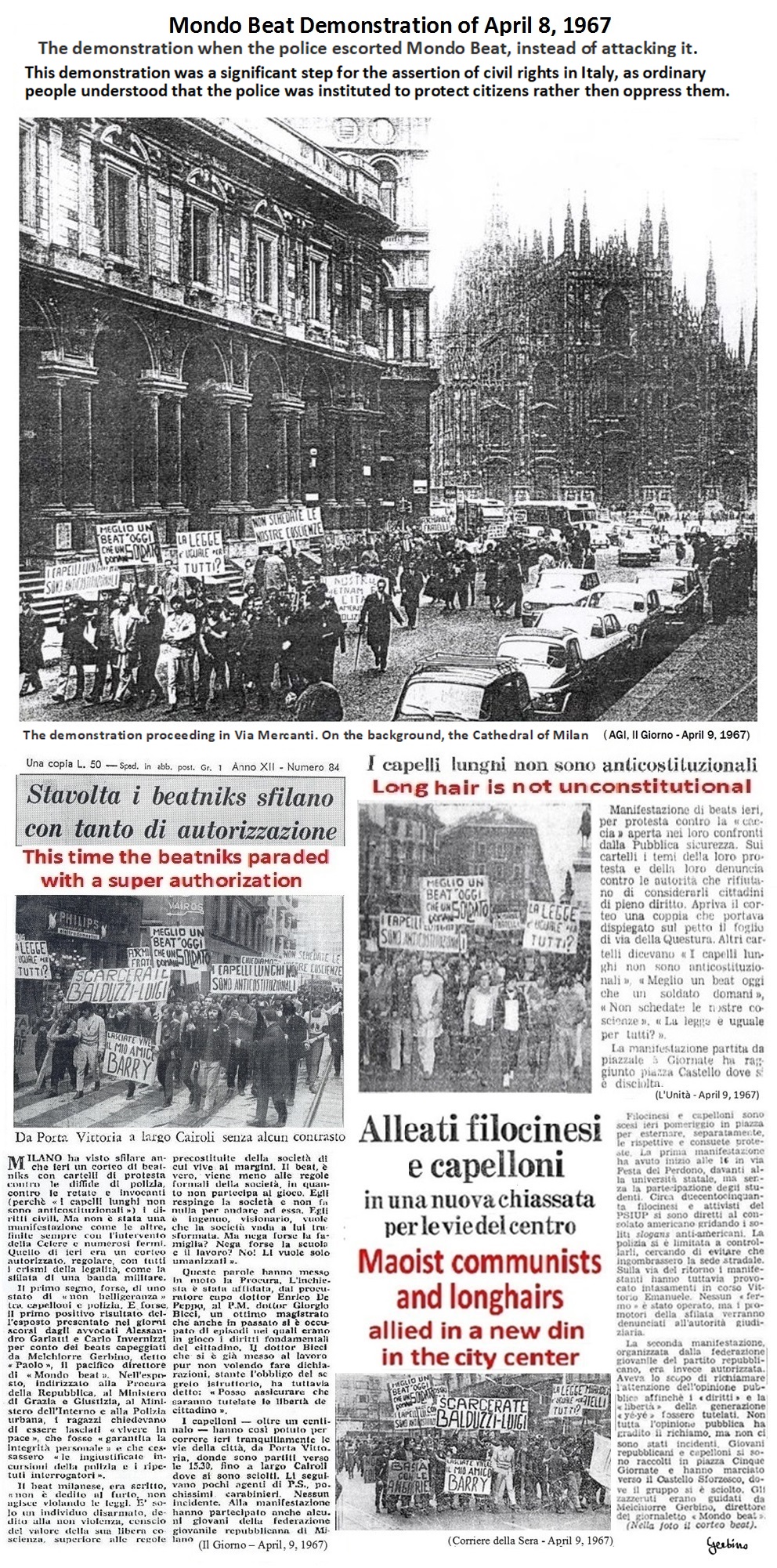
The demonstration when the police escorted Mondo Beat instead of attacking it.
This demonstration constituted a significant step for the affirmation of civil rights in Italy, since ordinary people understood that the Police had been established to protect citizens and not to oppress them.
Due to the wide media coverage of the complaint against the Police Headquarters and of the following demonstration, the Swedish leather coat that Melchiorre Gerbino wore during that wet winter in Milan and with which he went to Court and attended the demonstration, became an emblem. After him, other activists would have worn similar coats on the occasion of official events for the assertion of civil rights in Italy.
*
After the pacification with the Milan Police Headquarters, a lot has changed in the Mondo Beat Movement.
One positive aspect was that many visitors came to the Cave and since on the ground floor there was a permanent exhibition of paintings by the young people of the Movement, the paintings sold easily.
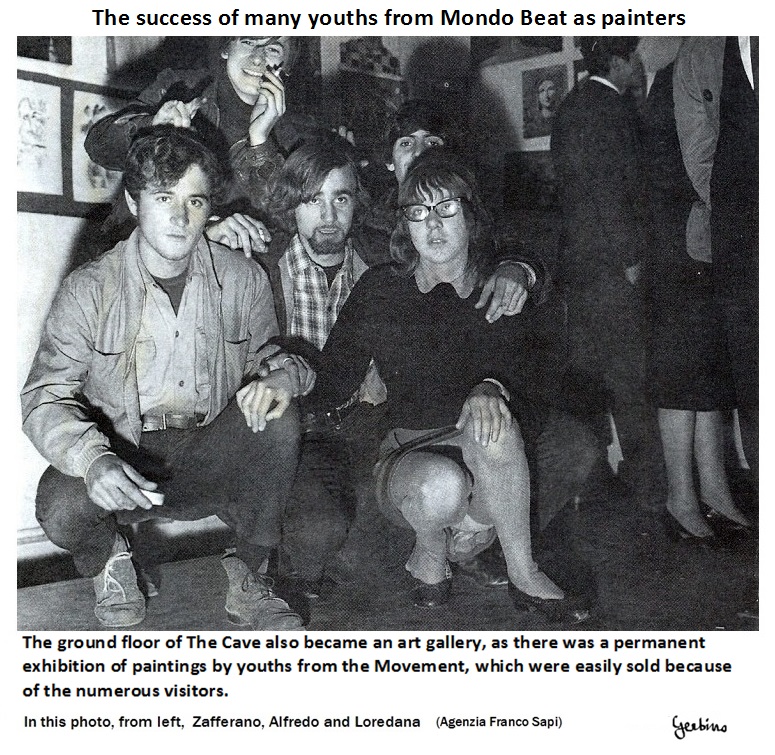
The ground floor of the Cave also became an art gallery.
But, on the other hand, reconciliation with the Police Headquarters would have created a critical situation. As soon as the news spread that the city of Milan was safe for the Beats, many young people arrived from all over Italy and with them young people from other countries and there were so many that the Cave could not contain them all. Many would have remained with their backpacks on the sidewalk, while many curious people would have crowded near the Cave and the traffic in Via Vcenza would often have remained paralyzed.
And to complicate the situation even more, Giorgio Contini's father arrived from Sardinia to bring him home, from where he had disappeared. Giorgio's photos had been published in newspapers and magazines and so his father had discovered that he was at Mondo Beat. Giorgio Contini was managing the cellar and the wardrobe of the Cave and was unique in his sensitivity and dedication. But however it was a good thing that his father arrived, Giorgio needed medical attention, as he suffered from bronchitis, having remained in the humidity of the cellar for too long.
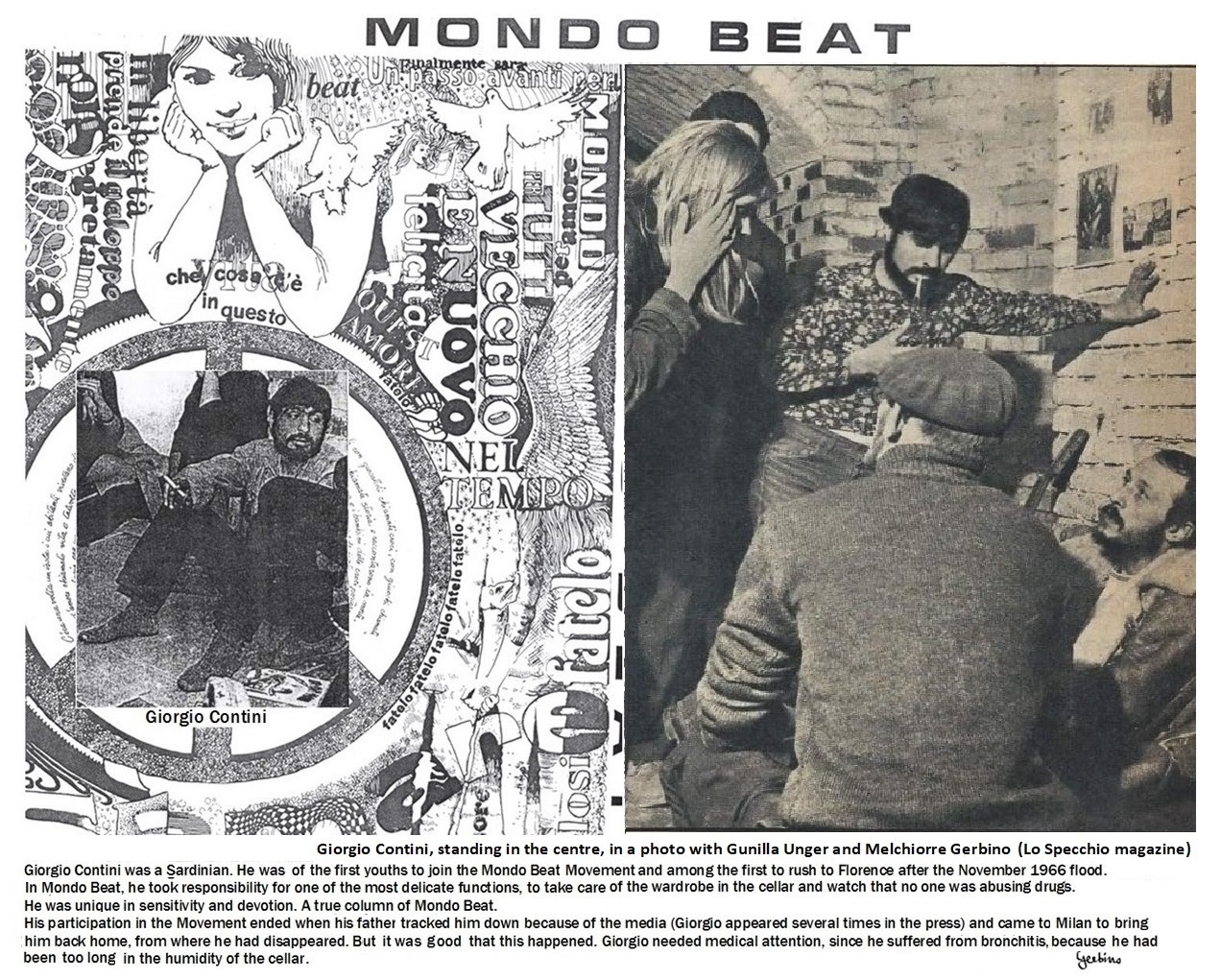
Giorgio Contini
Here a link to see
Giorgio Contini and Gunilla Unger
in the cellar of the Cave.
Furthermore, considering the situation in which Mondo Beat found itself after the pacification with the Police Headquarters, the risk was that, since it was easy and safe for everyone to come to the Cave to be photographed and appear in the press or to publish a poem in the magazine Mondo Beat, the Movement could have become a fashionable movement. It was therefore urgent to find a way to continue to be a breaking movement and since what truly destabilizes power is the loss of control over people's sexual behavior, Mondo Beat had to promote a sexual revolution to continue as a breaking movement. Thus, with the dual aim of getting out of the confusion created by the too high number of people crowding the Cave, and of triggering a sexual revolution, Umberto Tiboni and Melchiorre Gerbino decided to create a tent city on the outskirts of Milan, where anyone could pitch a tent for free or sleep on the grass. To find a lawn to rent, they gave task to Dante Palla, who knew all the dogs barking on the outskirts of Milan.
And on April 20 Dante Palla announced the good news. He had found a suitable place to set up a campsite. To get there you had to take tram 24 to the Vigentino terminus, then walk 10 minutes, and it would have been easy, since tram 24 had a stop on a corner of Piazza Duomo.
In fact, the place chosen by Dante Palla was ideal for creating a campsite. Large enough to accommodate many tents, the camp was bordered on one side by the wall of a factory; on the opposite side it was bordered by the Vettabbia torrent; in the direction of the road it was bordered by a row of bushes, behind which there was the square of a petrol station; in the opposite direction the fields extended to the Alps, which stood out on the horizon. The price agreed by Dante Palla with the owner of the land was 140,000 lire for 4 months' rent. Umberto Tiboni and Melchiorre Gerbino decided to rent the land as quickly as possible.
On April 23, four people from Mondo Beat went to the house of an old farmer with whom they had made an appointment. Melchiorre Gerbino put 140,000 lire in cash on the table and explained that they were boy scouts who wanted to camp as soon as possible. The farmer replied that we could enter the field whenever we wanted. A contract was then signed, valid from 1 May to 31 August 1967.
In this field the Mondo Beat tent city would have arisen, which the Corriere della Sera would have nicknamed Nuova Barbonia. Other reactionary newspapers would have called it Barbonia City, the two names having had the same meaning of "city of the new vagabonds". But that wouldn't have bothered us, these nicknames were funny and we would have liked them.
Barbonia City would have lasted 42 days, before the Vatican managed to have it destroyed by the Italian government, but the consequences of what happened in those 42 days are not yet calculable.


















